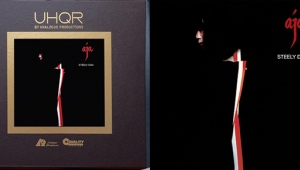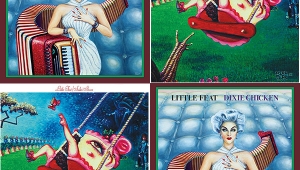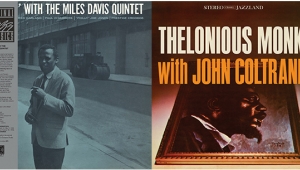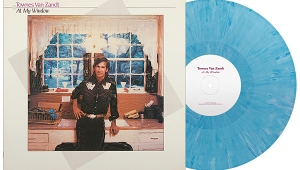| Columns Retired Columns & Blogs |
Revinylization #35: John Coltrane's Blue Train Remastered (Twice) for Tone Poet
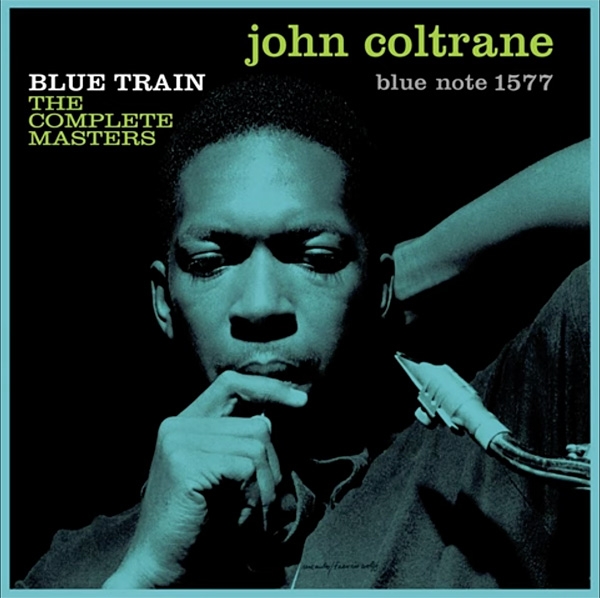
With its indelible Francis Wolff cover image of a pensive John Coltrane bathed in blue, freshly fired by Miles Davis but four months free of heroin, and its confident, accessible music that hints at the genius to come, Coltrane's Blue Train is a timeless jazz masterpiece. The saxophonist's only album as a leader for Blue Note, recorded before his triumphs at Atlantic Records—My Favorite Things and Coltrane Jazz—the boppy Blue Train, which, including the original mono and stereo pressings, had been issued 272 times, remains important for many reasons.
First, there's the wonderful playing. At 32 years old, Coltrane is at his lyrical best in the album's most famous tune—at least among Coltrane fans—a sweet, tender rendition of the Jerome Kern/Johnny Mercer ballad "I'm Old Fashioned." The hummable title track is a 10-minute blues that presages the saxophonist's leap forward into modal jazz. The fast "Locomotion" is a showcase not only for Coltrane but also for trumpeter Lee Morgan's high spirits and searing chops.
Blue Train is a rare instance of Coltrane recording with three horns. The others are a very young duo of players who punched above their weight: Curtis Fuller (trombone), age 24 when the session occurred in September 1957, and a very young Lee Morgan, age 19. The veteran rhythm section—drummer Philly Joe Jones and bassist Paul Chambers—is marvelous throughout. In contrast to Trane's impromptu sessions for the Prestige label, this album was captured after multiple rehearsals, a rule of Blue Note cofounder Alfred Lion. In its wake flows an unanswered question: Why didn't the saxophonist, who died in 1967, make another Blue Note record as leader?
The Blue Train reissue count has now reached 274, as fresh single- and double-LP versions—Blue Train and Blue Train: The Complete Masters—have been reissued as part of Blue Note's Tone Poet series. Remastered by Kevin Gray at Cohearant Audio and pressed at RTI, these new Blue Trains are, like all the Tone Poet releases, produced by Joe Harley, cofounder and producer of the Music Matters Ltd. series of high-quality jazz reissues.
With so many Blue Trains in existence, the question becomes: Why another? Harley gave two reasons. First, unlike the superlative Blue Train reissue he supervised for Music Matters in 2014, which was in mono, the two-disc version here is in stereo. The second impetus is seven outtakes, split between the title track, "Moment's Notice," and "Lazy Bird," that fill the second LP in the two-disc (stereo) version.
"I didn't know that there was a whole other record of outtakes," Harley said in a recent interview from his home in California. "And while a few of these outtakes have appeared on CD in the US and Japan, several have never been heard before, and none of them have ever been on vinyl."
Harley says this is the final word on Blue Train as far as any as-yet-unreleased material goes. "There are no more outtakes. They weren't kept, so what that probably means is they were taped over. And these weren't long sessions by modern standards. So I suspect that what we have is what there is."

One wonderful touch here, which distinguishes this reissue from all others, is studio patter from this all-star cast, which Harley decided to leave in. "I made it a point to include chatter. I had to think like a fan—what would I want? I always thought it would be cool to be a fly on the wall at the session. What was Lee Morgan saying to Philly Joe about doing some fours in the beginning of whatever take that was? I find that interesting, so I hope others are going to feel the same. There were things I didn't put in, like long stretches of silence eventually broken by Rudy going 'Are we ready?'" Laughter.
In the aftermath of the MoFi controversy, Harley is eager to dispel any misconceptions about the source material and how it is remastered. "There's a lot of misunderstanding about tapes. From the 1950s to about 1964–65, Rudy used Scotch 111 tape, which is acetate-based and tough as nails. God knows what's in it. We always joke that there's whale oil in there or something. Whatever it is, it became illegal sometime in the '60s, so it's probably bad. But they are robust, really tough. You put those masters up and it sounds like it was done yesterday.
"As far as any changes in the sound, Kevin and I didn't look at the mastering notes from the one we'd done before [for Music Matters]. We started fresh. And it's so well done to begin with. ... There were a couple of things in the low end and maybe something in the range of the cymbals that we may have done, but we're talking really small moves here."
As for the eternal mysteries of the wizard of Englewood Cliffs, who wore gloves while working and took great pride in being involved in every step of the record-making process, Harley, who at this point is closer to Rudy's ways than anyone else working today, has learned to decode the legendary Van Gelder sound.
"What Rudy did was very consistent. He would roll the low end because they had to keep those records sold. They didn't want returns, and they had to play on anything. Anything means any gear in the '50s. It's a pretty low bar. He also used compression. A lot of his notes say eight to one, which is not like modern-day rock or pop, where it's just slammed shut. He used compression to add a kind of excitement. My goal with all these is what's on the tape. How did they record it? What did they playback and listen to, and what became the master?"
- Log in or register to post comments




